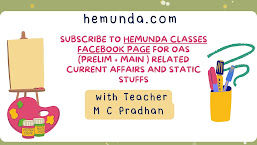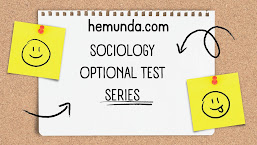Home Science, Paper-2, Section-B [Extension Education]
Chapter-6
Teaching & Learning in extension: Education, extension teaching methods, classification and selection of appropriate method, feature, advantage and limitation of different methods of teaching (mass, group, individual) Audiovisual aids – planning, selection and types of visual, audio and audio-visual aids contribution of audio-visual aids in extension teaching.
Past Years’ Questions from this chapter
Write on the different teaching methods and give the advantages and disadvantages of the same.[ 20 marks, OAS MAIN, 2017]
What is the relevance of audio-visual aids in the dissemination of information? [5 marks, OAS MAIN, 2016]
Critically examine the different education, extension teaching methods, and lists the merits and demerits of the same.[ 60 marks, OAS MAIN, 2015]
Importance and contribution of audio-visual aids in extension teaching[ 5 marks, OAS MAIN, 2015]
What extension teaching methods are suitable to teach time and energy-saving technologies to rural women? Explain with examples.[ 20 marks, OAS MAIN, 2006]
What are the important fields covered in the extension? How can A. V aids spread the rate of development in our country? Discuss by giving appropriate examples.[60 marks, OAS MAIN, 2006]
Write classification of extension teaching methods and how to select appropriate methods for effective communication. [ 20 marks, OAS MAIN, 2019]
What is the importance of A V aids in extension teaching? What are the different types? Write the advantages and disadvantages of the same.[ 30 marks, OAS MAIN, 2019]
TEACHING & LEARNING IN EXTENSION
EXTENSION TEACHING:
In order to bring about the desired changes in the behavior of people, the extension should
organize activities so that there will be a repetition of the desired behavior.
This conscious attention to the organization of teaching activities in a sequence greatly increases the efficiency of learning.
The Extension teacher, therefore, Plans & Arranges situations and activities to draw the attention of the prospective learner, develop his interest, arouse desire, create conviction, promote action & ensure satisfaction.
ATTENTION--------- INTEREST--------------- DESIRE----------CONVICTION--------ACTION ----------- SATISFACTION.
Steps in Extension Teaching
ELEMENTS OF A LEARNING SITUATION:-
1) Physical Facilities
2) Learners
3) Subject Matter
4) Instructor
5) Teaching Equipment
TEACHING METHODS:-
These refer to the devices used to create situations in which communication can take place
between the instructor and the learner.
Functions of Extension Teaching Methods:-
1) COMMUNICATION – Learner can see, hear & do things to be learned
2) STIMULATION – Causes Desired Mental & Physical Action on the part of learner
3) To take the learners through steps of the teaching-learning process – Attention, Interest, Desire,
Conviction, Action, and Satisfaction
CLASSIFICATION OF EXTENSION TEACHING METHODS:-
(A) According to Use
1) Individual contacts
(a) Farm & home visit
(b) Office calls
(c) Telephone calls
(d) Personal Letters
(e) Result Demonstrations
2) Group contacts
(a) Method Demonstration Meetings
(b) Leader Training Meeting
(c) Lecture Meetings
(d) Conference & Discussion Meetings
(e) Meeting at Result Demonstration
(f) Tours
(g) Schools
(h) Miscellaneous Meeting
3) Mass contacts
(a) Bulletins
(b) Leaflets
(c) News stories
(d) Circular Letter
(e) Radio
(f) Television
(g) Exhibits
(h) Posters
(B) According to Form
1) Written
(a) Bulletins
(b) Leaflets
(c) News Articles
(d) Personal Letters
(e) Circular Letters
2) Spoken
(a) General & Special Meetings of all kinds
(b) Farm & Home visit
(c) Office calls
(d) Telephone calls
(e) Radio
3) Visual or Objective
(a) Result Demonstration
(b) Exhibits
(c) Posters
(d) Motion Pictures, Charts, Slides & other visual aids
4) Spoken & visual
(a) Method Demonstration Meetings
(b) Meeting at Result Demonstration
(c) Meeting involving Motion Pictures, Charts, Slides & other visual aids
(d) Television
SELECTION OF APPROPRIATE METHOD:-
Leaders in Extension Education all over the world have concluded that principles & techniques
fundamentals in Extension Teaching are applicable to any country, community, locality, or village.
Adjustments & variations in the selection and use of Methods & Techniques have to be made
to fit the existing conditions and situations.
Classification of Extension Methods depending on the way of use by the Extension
workers:
1) Direct contact
2) Demonstration – Result and Method
3) Working with village leaders
4) Village Group Action
5) Visual Aids – Photographs, Posters, Black Boards, Bulletin Board, Flashcards, Flannel Graphs,
Puppets, Slides, Film strip, Films
6) Literature – News Paper, wall News Paper, Leaflets, pamphlets, and circular letters
7) Tours
8) Songs & Dramas
9) Specimens, Models Exhibits
INDIVIDUAL CONTACTS:-
It is a face-to-face contact by the extension worker with the farmer or family member for
one or more specific purpose connected with extension
Features:-
1) Obtain or give first-hand information on matters relating to farm or home conditions
2) Give advice or assistance to solve a specific problem or teach skills etc.
3) Arouse the interest of those not reached by other methods
4) Select Local Leaders, Demonstrators, or co-operators
5) Promote Good Public Relations
6) Contribute to the strengthening of the Extension organization or facilitate Extension
program.
Advantages:-
1) Provides First-hand information to the Ext. workers
2) It made on request, the farmer/home-maker is ready to learn
3) Ration of Acceptance to Efforts is HIGH
4) Build confidence between Ext. Worker & the learner
5) Increases the effectiveness of Group Methods & Mass media
6) Helps in the selection of Better Local Leaders, Demonstrators, and Co-Operators
7) Develop Good Public Relation
8) Useful in contacting those who do not participate in Ext. activities & who are not reached by
mass media.
Limitations:
1) Requires much time for Ext. worker
2) No. of contacts possible is limited
3) Costly in comparison to other methods
4) Time of visit may not be always opportune from the standpoint of the farmer
5) Danger of concentrating visits in the progressive farmers, and neglecting those who are most in
need of such personal contacts.
GROUP CONTACTS:-
It is a relatively short time demonstration given before a group to show how to carry out an
entirely new practice or an old practice in a better way.
Features:-
1) To enable the people to Acquire New Skills
2) To enable the people to Improve their old skills
3) To make the learners do things more effectively by getting rid of Defective Practices
4) To save Time, Labour & annoyances & to increase the satisfaction of learners
5) To give confidence to the people that a particularly recommended practice is a practical
Proposition in their own situation.
Procedure to be followed:-
1) Analyse the situation & Determine the need
2) Plan the Demonstration in detail
3) Recharge or practice the Demonstration
4) Give the Demonstration
5) Follow–up
Advantages:-
1) Peculiarly Suited in Teaching shells to many people
2) Seeing, Hearing, Discussing & participating in a group stimulates Interest Action
3) The costly ‘Trial & Error’ procedure is eliminated
4) Skill acquisition is made faster.
5) Build confidence in Ext. worker in himself and of the people in the Ext. worker
6) Promote repetition of the practice by local leaders
7) Introduces changes of practice at a Low cost
8) Provides publicity material
9) Facilitates sharing of knowledge & Experience, thereby strengthening Learning
Limitations:-
1) Suitable only for practices involving skills
2) Needs enough Preparation, Equipment & Skill by Ext. worker
3) May require considerable Equipment Transported to the workplace
4) Requires a certain amount of showmanship not possessed by some Ext. workers
5) Wide diversity in the interest of audience creators is a difficult learning situation.
6) Holding a meeting may become a “Real Objective”
7) Pitfall of working with caste groups or groups vested interests should be avoided
MASS CONTACTS:-
These enable the Ext. worker to greatly increase their teaching efficiency and
participate Dissemination of information to a large number of people at low cost
Features:-
1) These include Publications, Newspaper Articles, Circular letters, Radio, TV, Exhibits,
Posters etc.
2) Reach a large no. of people quickly and inexpensively.
3) Reach people not reached by other means
4) Stimulates participation in Ext. through all other media
5) Builds enthusiasm and maintains interest
Advantages:-
1) They reinforce individual & group contacts by complementing or supplementing them
2) They reach a much larger & different audience
3) They save time & expenditure in reaching large No.s
Limitations:-
1) Less intensive & less effective than individual & group contacts in bringing about changes
in practice
2) Lack the advantages of social contacts or ‘Personal Touch”
3) Recommendations, being general, may not apply to special situations or individual needs
4) Difficult to evaluate results
SELECTION OF EXTENSION METHODS:-
Our main objective is to reach more people, teach them more often, and keep down the cost per contact. To get the most effective result, the extension worker should-
A] Select Appropriate methods
B] Have a suitable Combination of the appropriate method
C] And use them in proper sequence, so as to have repetition in a variety of ways.
Audience-
A] Individual and collective Differences
Illiterate and low-income groups respond better to
Personal visits
Result Demonstration.
Educated / progressive people respond well to
Group meetings and Discussions.
Exhibits
Written materials
B] Size of Audience
Participants within 30 No.s- Group Discussion.
Small Audience- Method Demonstration
Large Audience- Lecture meetings.
2. Teaching Objective-
A] To inform or influence a large number of people slightly- Mass Media
B] To influence and make maximum improvement in a small number of people- Individual contact method.
C] To change an attitude or arrive at a consensus of opinion- Group Discussion or Work through Village leaders.
D] To teach a skill- Demonstration Method
3. Subject Matter
(a) If New practice is simple & Familiar – News Article, Radio, Circular letter
(b) Unfamiliar/complex practices – Face to face contacts written materials, Audiovisual Aids
4. Stages of Development of Extension Organisation
(a) Initial stages of Extension – Result Demonstrations
(b) Established Ext. work with the confidence of farmers in Ext. services – Local illustrations of
Adoption by village leaders
5. Size of Extension Staff
(a) Larger no. of Ext. workers – Direct & Personal contact
6. Availability of means of communication
(a) If available, Newspapers, Telephones, Radio, T.V can be used
7. Relative cost of Method
The amount expended on Ext. teaching in relation to the extent of practices changes is an
an important consideration in their selection and use.
8. Extension worker’s Familiarity
Extension worker’s familiarity with and skill in the use of the several Ext. Methods also influence his
choice & use of the methods
➨Our Ext. Plans of work must include methods that:
1) Enable our farmers to see, hear & do the thing to be learned
2) Enable us to reach a large no. of people
3) Create confidence-building situations
AUDIO-VISUAL AIDS
PLANNING FOR EFFECTIVE USE:-
1) Know clearly the objectives of the presentation
2) Plan well in advance to anticipate & avoid problems
3) Anticipate audience size as closely as possible & make sure that aids are visible/ audible to the entire audience
4) Plan for use of a variety of colorful visual aids which help change the pace of presentation & help to hold audience interest.
5) Determine the Appropriate Timing for Presentation
FACTORS INFLUENCING SELECTION
Audio-Visual aids are used singly or in combination, taking the following factors into
consideration:-
1) The Teaching Objective – the type of behavior change needed
2) Nature of Subject Matter being taught
3) Nature of Audience – Age level, Educational level, Interest, Experience, knowledge of the subject, Intelligence, etc.
4) Size of Audience
(a) Small Audience – Flashcards
(b) Large Audience – Motion Picture
5) Relative cost of various Aids
6) Ext. Teachers familiarity with & skill in using several aids, in their selection & preparation
7) Availability of Aid
TYPES OF AUDIO AIDS:-
1) Radio
2) Recordings- Tape, Disc, Wire
3) Sound commentaries – Public Address Equipment
TYPES OF VISUAL AIDS:-
1) Non projected
(a) Models, specimens
(b) Flannel Graphs
(c) Flashcards
(d) Photographs
(e) Illustrations
(f) Charts
(g) Posters
(h) Chalk Board
(i) Bulletin Board
2) Projected
(a) Slides
(b) Film Strips
(c) Silent Films & Motion Pictures
(d) Illustrations – projected through Epidiascope, opaque projector or overhead Projector
3) Others
(a) Exhibits
(b) Demonstrations
(c) Literature
TYPES OF AUDIOVISUAL AIDS:-
1) Sound Films
2) Television
3) Drama
4) Puppet shows
Contribution of Audio-Visual Aids in Extension Teaching:-
The Audio-Visual Aids help:-
1) The learners to learn faster, learn more, learn more thoroughly and remainder longer
2) The teacher to organize his teaching material in a systematic order
3) Clarify ideas being presented
4) Impress ideas more indelibly on the mind
5) Vitalise and make Teaching more real
6) Picture experiences outside one’s own environment
7) Combat verbalism or unnecessary or meaningless form of works
8) Overcome the language barrier
9) Attract & hold attention
10) Arouse & sustain Interest
11) Stimulate thinking & motivation activities
12) Change Attitude or Point of view
13) Save time as they make learning Easier & faster
Disadvantages of Audio-Visual Aids:-
1) Learners may sometimes form mistaken or distorted impressions unless supplemented with
required explanation
2) Teacher may narrow down his teaching to only narrow Ideas; not giving a complete picture of
the subject
3) Some teachers have mistaken ideas that they have little to do when audio-visuals are used
4) Risk of spectatorism Instead of the attitude of thoughtful inquiry.







































0 Comments
please do not enter any spam link in the comment box.